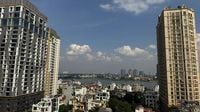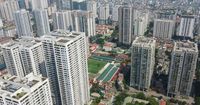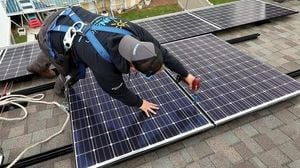The Hanoi apartment market is experiencing a notable shift as prices begin to stabilize after a period of rapid growth. Data from Batdongsan.com.vn indicates that the market has seen a plateau in pricing since late 2024, with many real estate brokers reporting flat asking prices and a downward trend in transaction volumes compared to the same period last year.
A recent report from CBRE Vietnam highlights that after a phase of intense growth at the start of 2024, the upward trajectory of apartment prices has started to level off. Currently, the average selling price in the primary market stands at approximately 75 million VND per square meter, reflecting a significant 34% increase from the same period last year, yet only a 3% rise compared to Q4 2024. This marks the lowest quarterly price increase recorded since Q2 2023.
In the secondary market, the increase in apartment prices has also slowed. By the end of Q1 2025, the average selling price for secondary apartments in Hanoi was around 50 million VND per square meter, which is nearly 20% higher than the same period in 2024 but again only a 3% increase from Q4 2024. This is the lowest quarterly increase since Q3 2023.
According to Savills, in the first three months of 2025, there was a significant disparity between the selling prices of primary apartments from developers and those in the secondary market. The average primary selling price reached 79 million VND per square meter, while the secondary price was only 60 million VND per square meter. A survey conducted by Savills on over 400 apartment projects in Hanoi revealed that 47% of these projects noted a decrease in secondary selling prices compared to the previous quarter, with the average decline being about 1% per quarter.
The widening gap between primary and secondary prices, particularly in the high-end segment, is notable. For Grade A projects, the difference can reach as much as 52%, while Grade B projects show a 21% difference, indicating that adjustment pressures are more pronounced in high-value products.
Ms. Do Thu Hang, Senior Director of the Advisory and Research Department at Savills Hanoi, attributed the high primary prices mainly to new supply being concentrated in large urban projects. In the first quarter of this year, new apartment supply in Hanoi amounted to 7,940 units, with Vinhomes Ocean Park, Vinhomes Smart Cities, and Vinhomes Global Gate accounting for 89% of the new supply and 90% of the units sold. Despite their locations being farther from the city center, these projects are shaping the primary price landscape due to their scale and amenities.
Another significant factor contributing to the decline in secondary apartment prices is the shift in investors' profit expectations. As primary prices remain high, buyers are increasingly turning to the secondary market in search of more reasonable pricing. Many investors, who previously achieved their expected profit levels, are now adjusting their strategies, accepting narrower profit margins to enhance liquidity and reallocating capital to markets that better match their new investment appetites. This shift has sparked a wave of price adjustments in the secondary market.
Mr. Nguyen Van Dinh, Chairman of the Vietnam Association of Real Estate Brokers, noted that the trend of lowering apartment prices had been anticipated. He explained that after increases of 50-70%, a price adjustment of 5-10% is negligible but nonetheless indicates that the market is no longer tolerating unreasonable selling prices. Buyers are becoming less willing to purchase homes at any price.
Echoing this sentiment, Ms. Nguyen Hoai An, Director of CBRE Hanoi, stated that the prolonged price increase of apartments in previous years, coupled with a rapid rate of growth, led many homeowners to develop inflated expectations regarding selling prices. However, as the market cools and transactions slow down, homeowners are compelled to recalibrate their expectations to facilitate sales. Nevertheless, Ms. An emphasized that the observed price reductions in some areas primarily reflect a decrease in seller expectations, and the likelihood of selling apartments at a loss remains very low.
Looking ahead, Ms. Hang noted that the secondary price adjustment process is no longer localized but is unfolding on a broader scale, clearly reflecting the pressure to rebalance supply and demand within the market. However, the current price reductions are still insufficient to trigger a significant surge in transactions between buyers and sellers. Thus, Savills predicts that secondary prices will continue to decline, particularly as buyers gain more options and the market becomes increasingly flexible.
In contrast, experts assess that the likelihood of a decrease in primary apartment prices in the second quarter of 2025 is low, although a repeat of the previous rapid increases is also unlikely. The remaining quarters of 2025 are expected to see new apartment supplies of around 7,400 units, with Grade B continuing to lead, accounting for 67%. In Q2 2025, new projects are anticipated to launch, boasting prime locations, reputable developers, and high construction quality, with prices potentially hovering around 100 million VND per square meter. Given that the current primary price level averages around 79 million VND per square meter, the chance of a price drop in Q2 appears slim.
Experts also predict that there may be adjustments in primary prices within the market. From Q3 to Q4 of 2025, as major projects such as Vinhomes Smart City and Ocean Park complete their sales, the market may welcome additional projects in less prime locations. This could create conditions for a slight adjustment in the primary price level in Hanoi.
Looking further ahead, Savills experts anticipate that by 2026, primary prices will trend downward as investors return to developing Grade C apartment products, a segment that has been nearly absent in recent times. The reintroduction of apartments priced below 2 billion VND will help the market align more closely with actual demand and foster a more sustainable balance between supply and demand.
Ms. An believes that while apartment prices may still see slight annual increases, it is unlikely that they will experience explosive growth as seen in previous periods. She emphasized that developers are currently required to carefully consider both selling prices and product innovation in light of the cooling market. "Developers must think critically about how to position their products this year. In 2024, similar products were able to attract buyers, so this year, the question is what new features or pricing strategies will make customers accept them. This will be a significant question for developers," Ms. An stated.






